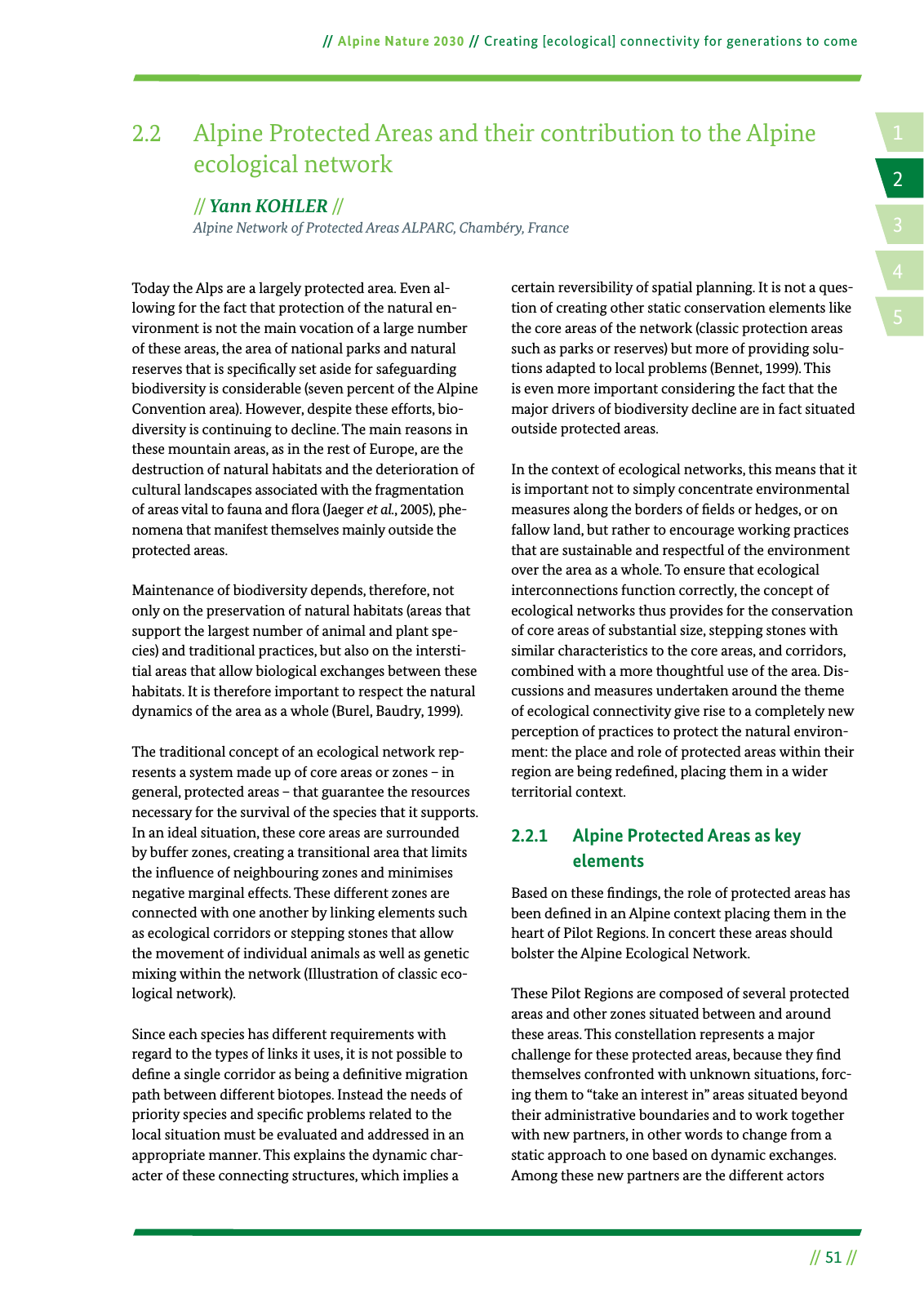14 2 5 3 51 Alpine Nature 2030 Creating ecological connectivity for generations to come 2 2 Alpine Protected Areas and their contribution to the Alpine ecological network Yann KOHLER Alpine Network of Protected Areas ALPARC Chambéry France Today the Alps are a largely protected area Even al lowing for the fact that protection of the natural en vironment is not the main vocation of a large number of these areas the area of national parks and natural reserves that is speci cally set aside for safeguarding biodiversity is considerable seven percent of the Alpine Convention area However despite these efforts bio diversity is continuing to decline The main reasons in these mountain areas as in the rest of Europe are the destruction of natural habitats and the deterioration of cultural landscapes associated with the fragmentation of areas vital to fauna and ora Jaeger et al 2005 phe nomena that manifest themselves mainly outside the protected areas Maintenance of biodiversity depends therefore not only on the preservation of natural habitats areas that support the largest number of animal and plant spe cies and traditional practices but also on the intersti tial areas that allow biological exchanges between these habitats It is therefore important to respect the natural dynamics of the area as a whole Burel Baudry 1999 The traditional concept of an ecological network rep resents a system made up of core areas or zones in general protected areas that guarantee the resources necessary for the survival of the species that it supports In an ideal situation these core areas are surrounded by buffer zones creating a transitional area that limits the in uence of neighbouring zones and minimises negative marginal effects These different zones are connected with one another by linking elements such as ecological corridors or stepping stones that allow the movement of individual animals as well as genetic mixing within the network Illustration of classic eco logical network Since each species has different requirements with regard to the types of links it uses it is not possible to de ne a single corridor as being a de nitive migration path between different biotopes Instead the needs of priority species and speci c problems related to the local situation must be evaluated and addressed in an appropriate manner This explains the dynamic char acter of these connecting structures which implies a certain reversibility of spatial planning It is not a ques tion of creating other static conservation elements like the core areas of the network classic protection areas such as parks or reserves but more of providing solu tions adapted to local problems Bennet 1999 This is even more important considering the fact that the major drivers of biodiversity decline are in fact situated outside protected areas In the context of ecological networks this means that it is important not to simply concentrate environmental measures along the borders of elds or hedges or on fallow land but rather to encourage working practices that are sustainable and respectful of the environment over the area as a whole To ensure that ecological interconnections function correctly the concept of ecological networks thus provides for the conservation of core areas of substantial size stepping stones with similar characteristics to the core areas and corridors combined with a more thoughtful use of the area Dis cussions and measures undertaken around the theme of ecological connectivity give rise to a completely new perception of practices to protect the natural environ ment the place and role of protected areas within their region are being rede ned placing them in a wider territorial context 2 2 1 Alpine Protected Areas as key elements Based on these ndings the role of protected areas has been de ned in an Alpine context placing them in the heart of Pilot Regions In concert these areas should bolster the Alpine Ecological Network These Pilot Regions are composed of several protected areas and other zones situated between and around these areas This constellation represents a major challenge for these protected areas because they nd themselves confronted with unknown situations forc ing them to take an interest in areas situated beyond their administrative boundaries and to work together with new partners in other words to change from a static approach to one based on dynamic exchanges Among these new partners are the different actors

Hinweis: Dies ist eine maschinenlesbare No-Flash Ansicht.
Klicken Sie hier um zur Online-Version zu gelangen.
Klicken Sie hier um zur Online-Version zu gelangen.